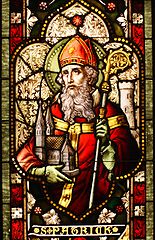
The Life And Writings Of Saint Patrick -Saint Patrick
II.—PATRICK IN MOYLURG
And now, bending first to the west and then to the south-east, the Saint fared onwards until he came to the Boyle river, for he was anxious to revisit some of his foundations in Moylurg. But when crossing over the rough bed of the river in order to go into Moylurg, as the Tripartite says, the chariot appears to have been upset at the ford, and Patrick fell into the Buall, ‘that is the river that comes out of Lough Techet.’ Thereafter the ford was called Ath Carpait, ‘the Ford of the Chariot,’ and it is near Eas Mic n’Eirc, close to which, we may add, the railway now crosses the river.
The Saint must have got both a wetting and a shaking, for the writer adds, in his usual style, that Patrick ‘cursed the eastern half of the river.’ ‘But why hast thou spared the western half?’ some one said—the part going up to Lough Gara—‘Because,’ said Patrick, ‘there shall come a Son of Life, who will set up there afterwards, and he will like to have a fruitful water at his stead.’ Patrick alluded to Columbcille, who afterwards founded a monastery at Eas Mic n’Eirc, the site of which may still be noticed in the old churchyard just beside the railway bridge over the river to the right going north, where the stream tumbles headlong over the rough ground. ‘The best fishing in Ireland every one has there still,’ adds the chronicler, ‘but from that down eastward there is not much fish caught.’ The story looks as if it were made up by some ingenious chronicler at a later period; but, beyond doubt, the stream is still fishful up to Lough Gara.
Now, as Patrick fared through Moylurg, that is the Plains of Boyle, the sons of Erc stole his horses—it would appear, too, that this was their second theft—and Patrick ‘cursed’ the people of that country. One could hardly blame him for denouncing their conduct in strong language, and foretelling its punishment. But the thieves had an intercessor. Bishop Maine, of the Hy Ailella—for Moylurg was then a part of the territory—whom Patrick had just set up in Aghanagh, besought Patrick to forgive his brethren; and his prayers ‘weakened the malediction.’ The good bishop even washed Patrick’s feet with his tears, and drove the stolen horses, now recovered, into a meadow, where he himself cleaned their muddy hoofs ‘in honour of Patrick.’ Patrick to some extent relented; still he said—‘there will be weeping, and wailing, and lamenting with the people of that country, and there will not be good neighbourhood amongst them in sæcula sæculorum’—as ‘is fulfilled,’ says the chronicler. Patrick said also that he would have afterwards a great part of that country; and that, too, was fulfilled, for Nodan of Loch Uama, now Cavetown, founded a church there, and gave its patronage to Armagh. This shows that Patrick founded the church of Eastersnow, and preached there in person. It was on the southern limit of Moylurg, and Patrick did not, on this occasion, so far as we can judge, travel further south.
No doubt, being now in North Roscommon, he may have visited Shankill and some other of his earlier foundations beyond Moylurg, and, perhaps, wintered there, but we have no intimation thereof; but the author of the Tripartite, as well as the original writer in the Book of Armagh, make it their purpose merely to record the missionary journeys of St. Patrick through the Island for the first time. Indeed, there is hardly a single instance in which we have any account of what would now be called a visitation of an existing church.
We can, however, trace with great probability Patrick’s return journey from Moylurg, where he probably wintered, in order to prosecute his purpose of going round the North of Ireland. From the neighbourhood of Easter-snow, where the Tripartite leaves him, we find him next coming to Doogary, the place which he first reached some years before after crossing the Shannon. It was just in his way to the north-east, for a glance at the map will show that if he came up to Moylurg, west of Lough Key, he would, by going north and by east, pass to the east of the Lakes, that is he would go by Ardcarne and Knockvicar, into that part of the modern parish of Cootehall, in which Doogary was situated.

 Keep Site Running
Keep Site Running